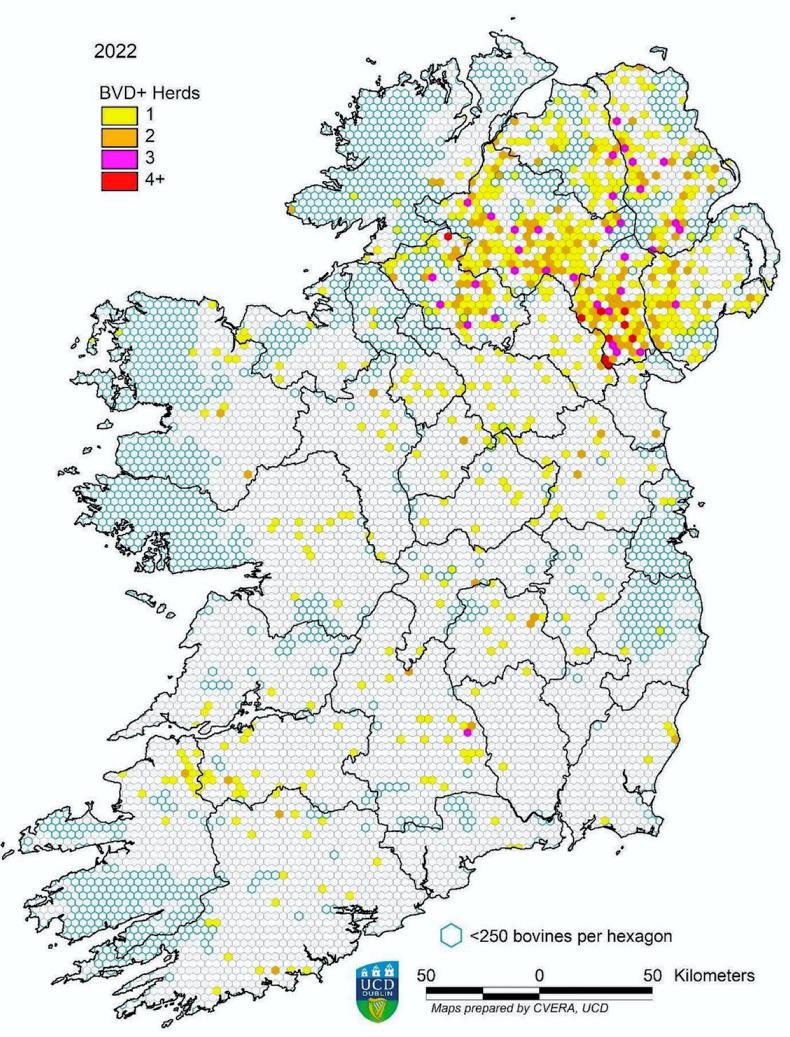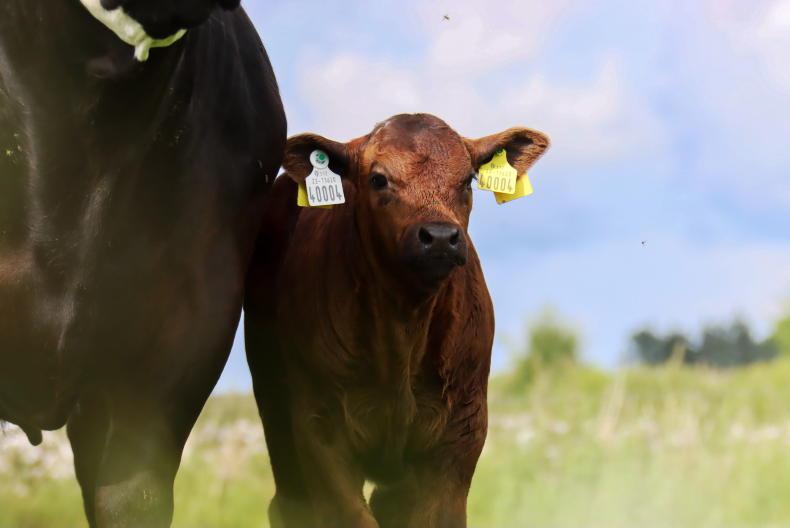Special care should be taken by herds in counties Monaghan and Louth to maintain bovine viral diarrhoea (BVD) biosecurity measures in the face of the disease’s higher incidence rates in Northern Ireland (NI), Animal Health Ireland (AHI) chief executive Dr David Graham has said.
2022 figures indicate that BVD is found in 3.76% of herds in the North and 0.45% of breeding herds in the south.
“While it is important that all herds take measures to prevent accidental introduction of infection, the higher levels of infection in NI, as compared to the Republic of Ireland, mean that herds in border regions, particularly in Monaghan and Louth, need to be especially careful given their proximity to infected herds in NI,” the AHI chief commented.
Graham’s remarks come after the publication of a map produced by the centre for veterinary epidemiology and risk analysis in UCD which shows the “marked progress” made by BVD eradication programmes north and south up to the end of 2022.

Map showing the distribution of herds with positive BVD test results in 2022. / UCD
There is separate but similar BVD eradication programmes run by the respective departments north and south of the border, both requiring mandatory tissue sampling of calves.
Tissue tagging has been compulsory in the south since 2013 and in the North since 2016.
Carlow BVD-free
AHI programme manager Dr Maria Guelbenzu commented that 2022 saw the first time an entire county’s calves were BVD-free – Co Carlow.
“During 2022, only 0.031% of calves tested returned a positive result, with these being found in only 308 (0.45%) of all breeding herds in the Republic of Ireland,” she said.
“This highlights the significant progress made since 2013, when 0.66% of calves from almost 9,000 herds tested positive.

There have been no BVD positive calves detected in Co Carlow since 2021. \ Shanon Kinahan
“At the end of July, 2.1 of the 2.4 million calves (88%) due in 2023 had been tested, with positive results returned from fewer than 200 herds.
“Co Carlow remains free to date, joined by Co Sligo, while a number of other counties have only a single herd with positive results.”
Testing still key
Graham added that the key measures of testing calves and removing infected animals remain vital for further progress in combatting the disease.
“Following approval of our eradication programme by the European Commission in 2022, the goal is now to reach the position where an application for recognition of freedom can be made,” he continued.
“It is vital that calves continue to be tagged and samples submitted promptly for testing, allowing infected calves to be identified and removed as quickly as possible, alongside efforts to prevent accidental transmission of BVD virus to other herds.
“This may occur through the movement of animals which may be undergoing a transient infection or which are pregnant and carrying a persistently infected calf.”
He stated that transmission may also occur via contact between animals at field boundaries or through movement of contaminated equipment or people between herds.
NI progress
Chief executive of Animal Health and Welfare NI (AHWNI) Dr Sam Strain stated that the new map demonstrates “substantial advances” made in taking down BVD levels in both eradication programmes.
“The animal-level incidence of BVD within NI has fallen by over 70% since the start of the compulsory programme to 0.264% in 2022, with these being found in 3.76% of herds,” Strain said.
“Crucially, the number of persistently infected animals that have been retained following identification has dropped dramatically in the last year, thus reducing the infection pressure on affected farms and their neighbours."
Strain also acknowledged higher levels of BVD in some border counties and urged concerted action by all stakeholders to eliminate the disease as quickly as possible.
“However, there are areas with higher levels of infection in NI, particularly along the Co Armagh border with Co Monaghan.
“AHWNI continues to engage with all farmers who are dealing with BVD breakdowns to encourage eradication of the virus at the farm level.”
Special care should be taken by herds in counties Monaghan and Louth to maintain bovine viral diarrhoea (BVD) biosecurity measures in the face of the disease’s higher incidence rates in Northern Ireland (NI), Animal Health Ireland (AHI) chief executive Dr David Graham has said.
2022 figures indicate that BVD is found in 3.76% of herds in the North and 0.45% of breeding herds in the south.
“While it is important that all herds take measures to prevent accidental introduction of infection, the higher levels of infection in NI, as compared to the Republic of Ireland, mean that herds in border regions, particularly in Monaghan and Louth, need to be especially careful given their proximity to infected herds in NI,” the AHI chief commented.
Graham’s remarks come after the publication of a map produced by the centre for veterinary epidemiology and risk analysis in UCD which shows the “marked progress” made by BVD eradication programmes north and south up to the end of 2022.

Map showing the distribution of herds with positive BVD test results in 2022. / UCD
There is separate but similar BVD eradication programmes run by the respective departments north and south of the border, both requiring mandatory tissue sampling of calves.
Tissue tagging has been compulsory in the south since 2013 and in the North since 2016.
Carlow BVD-free
AHI programme manager Dr Maria Guelbenzu commented that 2022 saw the first time an entire county’s calves were BVD-free – Co Carlow.
“During 2022, only 0.031% of calves tested returned a positive result, with these being found in only 308 (0.45%) of all breeding herds in the Republic of Ireland,” she said.
“This highlights the significant progress made since 2013, when 0.66% of calves from almost 9,000 herds tested positive.

There have been no BVD positive calves detected in Co Carlow since 2021. \ Shanon Kinahan
“At the end of July, 2.1 of the 2.4 million calves (88%) due in 2023 had been tested, with positive results returned from fewer than 200 herds.
“Co Carlow remains free to date, joined by Co Sligo, while a number of other counties have only a single herd with positive results.”
Testing still key
Graham added that the key measures of testing calves and removing infected animals remain vital for further progress in combatting the disease.
“Following approval of our eradication programme by the European Commission in 2022, the goal is now to reach the position where an application for recognition of freedom can be made,” he continued.
“It is vital that calves continue to be tagged and samples submitted promptly for testing, allowing infected calves to be identified and removed as quickly as possible, alongside efforts to prevent accidental transmission of BVD virus to other herds.
“This may occur through the movement of animals which may be undergoing a transient infection or which are pregnant and carrying a persistently infected calf.”
He stated that transmission may also occur via contact between animals at field boundaries or through movement of contaminated equipment or people between herds.
NI progress
Chief executive of Animal Health and Welfare NI (AHWNI) Dr Sam Strain stated that the new map demonstrates “substantial advances” made in taking down BVD levels in both eradication programmes.
“The animal-level incidence of BVD within NI has fallen by over 70% since the start of the compulsory programme to 0.264% in 2022, with these being found in 3.76% of herds,” Strain said.
“Crucially, the number of persistently infected animals that have been retained following identification has dropped dramatically in the last year, thus reducing the infection pressure on affected farms and their neighbours."
Strain also acknowledged higher levels of BVD in some border counties and urged concerted action by all stakeholders to eliminate the disease as quickly as possible.
“However, there are areas with higher levels of infection in NI, particularly along the Co Armagh border with Co Monaghan.
“AHWNI continues to engage with all farmers who are dealing with BVD breakdowns to encourage eradication of the virus at the farm level.”








 This is a subscriber-only article
This is a subscriber-only article










SHARING OPTIONS: